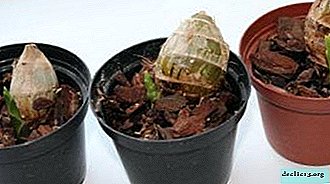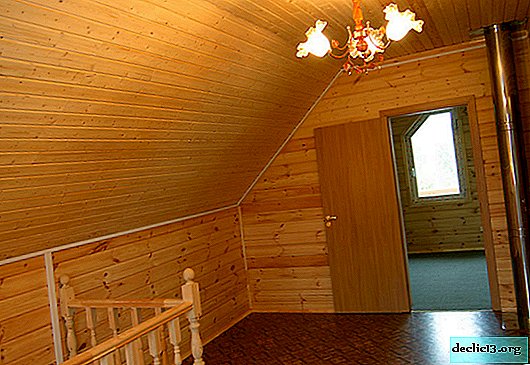Prickly beauty in the garden: description and varieties of park roses, cultivation and care

For harsh climatic conditions in Russia, a park rose is an excellent solution for decorating the garden.
This type of prickly beauties, in most cases, allows you not to use shelter for the winter.
Today in the article we will tell you what varieties of park roses are, how they differ from the rest, and also give detailed instructions for the proper cultivation and care.
What is it - a description
The ancestor of the park rose is wild rose hips. During a long selection selection, he was cultivated, resulting in a plant unrivaled in beauty and endurance.The height of the bushes under favorable conditions can reach up to one and a half meters. Buds can be of various shades: from snow-white to rich bloody. There are also non-standard colors for roses - orange and purple.
History of occurrence
Park roses were bred in England at the end of the 20th century, through complex crossbreeding. Sometimes this species is called "Austin", after the name of the creator, breeder David Austin.
What is the difference from the rest of the species?
A feature of park roses is a one-time flowering, which lasts a month. Hybrid forms can bloom up to two months. Gradually, the efforts of breeders create varieties that can bloom several times throughout the season.
Varieties with names and photos
Westerland
Tall, straight, well-branched, spiny bush with elongated dark green foliage. It is capable of repeated flowering. Inflorescences are loose brushes in which 5-10 pieces of large, semi-double orange-red flowers are collected.

Westerland Rose Variety Video:
Leonardo da Vinci
The most frequently planted species in our latitudes. It is characterized by large, up to 10 cm diameter buds. Flowers are bright pink in color, goblet, densely terry. They have a not pronounced delicate aroma. The bush does not grow above a meter and is considered suitable for both single and mixed plantings.

Winnipeg Parks
Thickly leafy matte bush. The flowers are cherry red, solitary or collected in small brushes. Each individual flower exuding a delicate aroma does not last long, but the entire bush blooms profusely and continuously.

Video about the Winnipeg Parks rose variety:
Moden blush
Erect, low bushes, about a meter wide with dark, slightly shiny foliage. Flowering is plentiful, up to the very frosts. Terry flowers, flattened, with a diameter of seven centimeters, have a faint aroma. The color of the petals is pearl pink; it brightens noticeably in the sun.

Video about the Modena Blush variety of roses:
Louis odier
Variety with neat terry flowers. Abundant flowering, a series of waves. Under the weight of flower buds, the stems bend, creating the effect of a waterfall of cup-shaped flowers of pink color - dark in the center and pale pink at the edges. The bush is powerful, the foliage is pale green. The variety is suitable for single plantings.

Gislen de feligond
Resistant to disease, vigorous, almost spiky, re-flowering bush. The buds are bright orange, the flowers are cup-shaped, pale apricot, fade to white. The foliage is large, bright green.

Paul Bocus
Dense flowers with a diameter of 8-10 cm with pink outer petals and orange inner. Exhaust a pronounced aroma. Abundant flowering, repeated, to frost. Matte foliage, resistant to diseases. The bush can reach one and a half meters in height and a meter in width.

Cinderella
The bush is erect, with dark green, dense, lacquered foliage, 120 cm in height. Cup-shaped flowers of pale pink color have a pronounced aroma of green apple.

Gita renaissance
Strong, branched, half-meter bush with shining foliage. Flowers, 10 cm in diameter, have a classic shape, pale pink color and delicate aroma.

Rayne Lucia
The variety is characterized by terry, lemon, non-fading flowers. The dense leafy bush does not exceed 150 cm in height, forms a rigid frame and is therefore ideal for picturesque hedges.

Scrub Parks
A medium-sized scrub with dark, glossy leaves. The flowers are white with a cream tint. The aroma can be felt at a distance.

School gel
Large-flowered variety. On the outer edge, the petals are pink with a peach tint on the back, the inner petals are soft coral with a rich apricot reverse. The shoots are very spiky, the leaves are dark green.

Prairie Joy
A strong, branched, low-prickly bush in height can reach one and a half meters, and a width of 125 centimeters. The flowers are large with a pleasant, not pronounced aroma. The buds are deep pink. The variety is often used to create hedges, on the same bush, densely-double and semi-double inflorescences are combined.

Video about the Prairie Joy variety:
Marie quiz
A variety reaching a height of 140 cm and a width of 125 cm, blooms profusely in large terry flowers of a silver-pink hue, the back of the petals is a delicate peach color.

Video about the rose variety Marie Quiz:
Rossion (Rossion)
Adult specimens grow up to one and a half meters in height, have large flowers of a cold pink and lilac hue. The bush is frost-resistant and resistant to disease.

Gertrude Jekyll
Juicy pink flowers in an old style, exude a strong aroma. Essential oil for perfumes is made from the petals of this variety. The bush is erect, well leafy, very prickly.

East park
A small bush with rich green glossy foliage. Flowers are single, cup-shaped, densely double, fragrant, pink-apricot, darker towards the center.

Elmshorn
A wide sprawling bush, 1.5 meters high with shiny, slightly wrinkled leaves, covered with large frequent spikes. Flowers are weak-spirited, densely pink, pompon-like, with a diameter of 4 cm, collected in inflorescences up to 40 pieces each.

Video about the Elmshorn rose variety:
Fluorescent
A variety with low winter hardiness, it can withstand frosts without shelter up to minus twenty degrees. The bush is upright, erect, densely strewn with rich red flowers, collected in brushes of five pieces. It blooms throughout the summer, until frost, the flowers do not fade.

Lucia Lichtengenigen
The variety is characterized by elegant elongated buds with red tips, which, when opened, become cup-shaped, have a yellow color and beautiful golden stamens. Flowers are collected in brushes of 5-15 pieces. The bush, not exceeding one and a half meters in height, forms a rigid frame and is covered with fine shiny foliage.

Piano
Winter-hardy repair grade. The bush is low, in width can reach up to 60 cm. The flowers are large, 11 cm in diameter, terry saturated pink color, collected in inflorescences of five pieces. The plant blooms profusely several times a season, is not susceptible to disease.

Claire rose
Thick double rose of pale pink color. Flowers with many small petals, collected in a brush of five pieces. The bush is vigorous, the rose is magnificent in cut.

Video about the rose variety Claire Rose:
Valerie de Montgolfier
Erect, meter-long, densely leafy bush with matte dark green foliage. It blooms profusely, repeatedly, with dense orange-red flowers. It has a delicate fruity aroma.

Tom tom
The bush is stiff, erect, low, winter-hardy. Saturated pink color. The flowers are large, collected in large brushes of 8-20 pieces.

Bloom
How and when?
Park rose begins to bloom in late May - early June. The flowers are terry. At the same time on the bush they can form up to 150 pieces. The flowering period lasts more than a month.
Care before and after flowering
- Before flowering, it is necessary to pinch all the strong growths, this stimulates the formation of flowering shoots.
- Withered flowers must be removed regularly - this is a very useful procedure for repair varieties of park roses.
What to do if it does not blossom?
The reason for the lack of flowering may be a lack or excess of fertilizers applied to the soil. To solve the problem, you need to adjust the composition and feeding regimen. During the formation of buds, pink bushes can be fed with infusion of wood ash.
The rose may not bloom due to improper wintering. In order for the hibernation period to pass for the plant comfortably, all recommendations for preparing the bush for winter should be followed.Use in landscape design
 Park roses are actively used in vertical gardening and ideal for creating hedges. Look great in both single and group landings.
Park roses are actively used in vertical gardening and ideal for creating hedges. Look great in both single and group landings.
- For the arrangement of hedges, varieties with hardy stems and dense branches are selected that can create a high-density wall.
- For vertical gardening, roses of climbing or liana-like varieties are used, capable of twisting around complex shaped supports.
Growing and Care Instructions
Seat selection
- In order for roses to please their flowering more than one season, a sunny place should be provided, which is well ventilated and protected from drafts.
- In shaded areas, park roses can also grow, but in this case their bloom will not be plentiful.
- Groundwater close to the surface should be absent.
What should be the soil?
The park rose is not whimsical to the soil. Almost any one will do, but clayey with a high humus content is the best for the plant. Heavy land on the site can be improved by adding peat or compost. Too light soil can be optimized by adding turf soil.
Landing
- Sowing of seeds in the soil occurs in June.
- Each seed should be located in the hole, 4 cm deep at a distance of 20 cm from each other.
- The first sprouts will appear in two weeks.
When growing roses from seeds, you can use the seedling method:
- Seeds are sown in special peat pots in February.
- Seedlings are planted in the soil in the same pots.
Temperature
Park rose belongs to frost-resistant representatives of prickly beauties, The minimum temperatures that this plant can withstand reach 30 degrees. A comfortable summer temperature for a rose is 25-28 degrees. Thermometer readings above 30 degrees for some varieties of park roses are fraught with burnout of petals.
Watering
 Park rose perceives watering gratefully. Therefore, the procedure should be carried out with plenty of water two to three times a week. It is important that the soil is deeply saturated with water, it is better to water less often, but abundantly than often and a little.
Park rose perceives watering gratefully. Therefore, the procedure should be carried out with plenty of water two to three times a week. It is important that the soil is deeply saturated with water, it is better to water less often, but abundantly than often and a little.
The soil should be constantly a little damp. When watering, you need to focus on the weather. By the end of summer, watering is stopped so that roses do not build up young shoots and begin to prepare for winter.
Top dressing
You need to start fertilizing the rose from the second year after planting, when the organic matter in the soil is gradually used up. Organic top dressing or special complex fertilizers for roses are suitable for this. They feed the rose 1-2 times a month.
Pruning
Pruning is a very important procedure for a park rose, which, however, is not recommended in the first two years after planting. After this period, the rose bush must be shaped into a bowl, removing weak and sluggish shoots, leaving only the most powerful and stable.
Growing up, the park rose grows and loses its well-groomed appearance, at this time you need to conduct a rejuvenating pruning. The oldest stems are chopped off in autumn along with non-flowering branches and shallow shoots.
Important! Only re-flowering varieties can be pruned. Once blooming can form inflorescences only on last year's shoots.Transfer
The best time for transplanting adult roses is early spring and late autumn. The procedure is carried out as follows:
- The new place in terms of illumination and soil composition should not differ from the old one, or differ for the better.
- A landing pit is being prepared and refueled according to the requirements of a particular grade.
- In and near the pit, all weeds must be removed.
- After preparing the place, you need to wait a while for the pit to settle.
- You need to water the rose well, tie up spiky branches, and pull out the bush with an earthen lump, after digging it up.
- Put a rose with a lump in a landing pit, fill the ground to half, spill heavily with water and wait until it is absorbed.
- To fill up the earth and ram it around the bush so that there are no air voids near the roots of the rose.
Preparation for winter
Mature park rose bushes can’t be covered they are resistant to low temperatures, but if the plant is young enough, you need to prepare it for winter by hilling the base of the bush with earth and wrapping the branches in several layers with craft paper.
How to propagate?
 The easiest way to propagate a park rose is to root layering. This is done as follows:
The easiest way to propagate a park rose is to root layering. This is done as follows:
- Annual shoots are laid in grooves dug near the bush in the spring.
- At the nodes, the bark is slightly incised.
- Stacked shoots are nailed, watered and covered with earth.
- Periodically watered in the summer, dig out in the fall or spring.
- Divided by the number of rooted parts and planted for growing in fertile soil.
- A year later, the rose is planted in a permanent place.
Diseases and Pests
- Park rose is prone to powdery mildew. The leaves are covered with white coating, the shoots are curved.
- Shrubs can infect bacterial cancer when growths form on the roots that block the plant's access to moisture and nutrients.
- Of the pests, raspberry weevil and garden raspberry do the most harm.
Careful care of garden beauties will allow you to fully realize how perfect the decoration of the site with rose bushes can be.

















